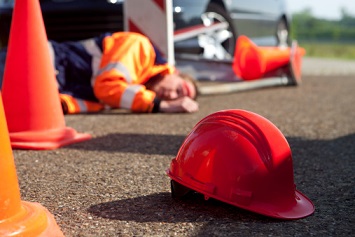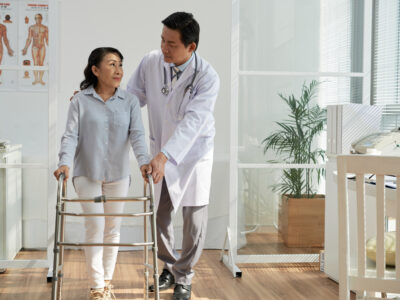There are several ways you could get injured on the job if you do physically active work like construction. Understanding common workplace injuries will help you better prepare yourself to work safely.
Slips and Falls
Falls are among the most common workplace injuries. These kinds of accidents account for one-third of workplace injuries. Possible injuries that can come from this include broken bones, pulled muscles, and back injuries.
To avoid these types of injuries, make sure that you’re careful about where you’re walking and check to see if the ground is wet. You may be working in an area with bad lighting, so being extra cautious in these types of situations is important. If you do encounter an area with a wet floor or other obstructions on the ground, alerting your employer could help prevent other workers from having an accident.
Vehicle-Related Accidents
Many physically demanding jobs use vehicles like trucks, and because of this, vehicle-related accidents are possible. Workers could be hit by a vehicle, get into a car crash, get hit by things that fall from a vehicle, or fall from a vehicle. These are just some of the many injuries that can result from an auto accident. Maintaining the correct speed limit and making sure routes avoid pedestrian areas can help ensure a safer environment.
Repetitive Stress Injuries
As one of the fastest-growing workplace injuries, repetitive stress injuries include over 100 types of injuries caused on the job. This type of injury can stop a worker from being able to perform their job. Lifting things improperly or lifting very heavy items often causes injuries. Ways to avoid this type of injury include taking breaks to rest and stretch. Being able to switch between a lifting task and a less intense task can also reduce pain.
Additional Types of Workplace Injuries You Should Know
Beyond the common injury categories, workers are often affected by:
- Falling Objects: Leading to head trauma, fractures, and lacerations.
- Electrocution: Especially among electricians or those working near power lines.
- Chemical Exposure: May result in burns, poisoning, or respiratory illnesses.
- Noise-Induced Hearing Loss: Often overlooked but prevalent in manufacturing and construction.
What Are the Most Dangerous Jobs for Workplace Injuries?
Some roles carry higher injury risk due to their physical nature or environment:
- Construction Workers – Slips, trips, falls, and machinery-related trauma.
- Warehouse Workers – Crush injuries, forklift accidents, RSIs.
- Healthcare Professionals – Back injuries, stress disorders, needle pricks.
- Agricultural Laborers – Equipment hazards, repetitive strain, chemical contact.
Mental Health and Psychological Effects of Workplace Injuries
Workplace accidents can have long-lasting psychological impacts, including:
- Post-Traumatic Stress Disorder (PTSD) after severe falls or vehicle crashes.
- Depression or anxiety following extended recovery or job loss.
- Sleep disturbances or substance misuse due to chronic pain.
Employers are encouraged under OSHA recommendations to provide access to mental health support and Employee Assistance Programs (EAPs).
How to File a Workplace Injury Report in California
In California, reporting your workplace injury correctly is crucial:
- Inform your employer immediately, ideally within 30 days.
- Request and complete the DWC-1 claim form.
- Seek medical evaluation through your employer’s provider.
- Keep copies of all documents and communications.
- Consider consulting a workers’ compensation attorney to understand if your rights are being honored.
According to California Labor Code S132a, employers cannot retaliate against workers who file for benefits.
Learn more on our Workers’ Compensation Services page.
Post-Injury Recovery and Legal Protection
Your recovery might require:
- Temporary or Permanent Disability Benefits
- Modified job duties or accommodations
- Physical therapy or surgery
- Mental health support or vocational rehab
If your injury leads to a functional impairment, you may also be eligible for long-term compensation and job retraining support through California’s Supplemental Job Displacement Benefit (SJDB) program.
Frequently Asked Questions (FAQs)
What are the most common workplace injuries?
Falls, vehicle accidents, repetitive strain, and contact with objects are most common.
Can I get compensation for long-term pain after an injury?
Yes, if the pain is medically verified and affects your work capacity, you’re entitled to benefits.
What’s the first step after a work injury in California?
Immediately inform your employer and request the DWC-1 form to initiate the claims process.
Are psychological injuries like PTSD compensable?
Yes. Under California law, emotional and psychological injuries are compensable if linked to a workplace incident.
How can I protect myself legally after an injury?
Document everything, avoid signing anything without legal advice, and consult a lawyer specialized in California workers’ comp law.
Get Help From a California Workers’ Compensation Lawyer
If you’ve been hurt on the job, whether it’s a fall, back injury, or chronic stress condition, you deserve trusted legal support.
Contact Hussain & Gutierrez for a Free Consultation
We’ll help you understand your rights, file your claim properly, and pursue maximum compensation.



